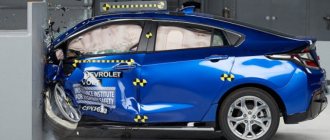Efficient but expensive fuel
The public is already accustomed to the struggle for the popularity of hybrids, cars with internal combustion engines or electric cars. The latter currently occupy the most advantageous position, but could someone else appear more efficiently and environmentally friendly? Then it’s worth remembering about hydrogen fuel transport. Such cars are very similar to electric cars in the absence of harmful emissions, but the main advantage of refueling is that it takes about 10 minutes to fill a hydrogen cylinder to capacity, and there is enough fuel for a distance of 500 km. It seems much more profitable than an electric car, but is it really so?
Pros and cons of cars running on hydrogen
Among the main advantages of hydrogen vehicles are:
- high environmental friendliness, consisting in the absence of most harmful substances in the exhaust, characteristic of the operation of a gasoline engine - carbon dioxide and carbon monoxide, sulfur oxides and dioxides, aldehydes, aromatic hydrocarbons;
- higher efficiency compared to gasoline cars;
In general, the car has ambitions to conquer the whole world
- lower noise level from engine operation;
- lack of complex, unreliable fuel supply and cooling systems;
- possibility of using two types of fuel.
In addition, cars running on an air-intake engine have less weight and more useful volume, despite the need to install fuel cylinders.
The disadvantages of hydrogen vehicles include:
- the bulkiness of the power plant when using fuel cells, which reduces the maneuverability of the vehicle;
- the high cost of the hydrogen elements themselves due to the palladium or platinum they contain;
- imperfect design and uncertainty in the material used to manufacture hydrogen fuel tanks;
- lack of hydrogen storage technology;
- lack of hydrogen filling stations, the infrastructure of which is very poorly developed throughout the world.
However, with the transition to mass production of cars equipped with hydrogen power plants, most of these shortcomings will certainly be eliminated.
History of hydrogen cars
Back in the 1990s, manufacturers delved into developing vehicles that ran on fuel cells. The main reason for searching for alternative fuel is the introduction of new CO2 emission standards and the energy crisis. The only environmentally friendly cars of that time, electric cars, had several limitations: long battery charging, short range, and expensive components. As a result, companies began to look for another way to power the machine.
Hydrogen was chosen as the main fuel element. Chemical properties, environmental friendliness and prevalence in the environment prompted engineers to think that working with this substance could bring income and impressive prospects. Hydrogen cars had to travel the same distances as their gasoline counterparts, with the same power and speed. However, the main difficulty was different - how to manufacture the necessary engine and direct the energy of the fuel cell in the right direction?
It turns out that the first hydrogen-powered internal combustion engine was invented back in the century before last. Most experts lean towards the research of the French naturalist Francois de Rivaz, who at the beginning of the 19th century produced hydrogen by electrolysis of water. In the modern world, large manufacturers almost simultaneously released hydrogen cars with similar basic technical “stuffing”.
The principle of operation of hydrogen cell cars
The operating mechanism and types of motors are very similar to the operation of electric vehicles, but the main difference is in the method of generating energy. Fuel cell cars also use electricity to move, but they don't get it from being charged by a power outlet. Energy is generated in the process of physical and chemical reactions that occur in the unit itself. The operating principle is as follows:
- The car is fueled with hydrogen, which comes into contact with oxygen and a catalyst. As a result, an electric current is generated that energizes the engine and battery.
Such vehicles are refueled at special stations that independently produce hydrogen using water electrolysis. Car maintenance means replacing hydrogen cells that have exhausted their service life. Typically the catalytic membrane is replaced, which helps generate electricity.
Design and principle of operation
The main difference between hydrogen engines and the gasoline or diesel analogues we are now familiar with is the method of supplying and igniting the working mixture. The principle of converting the reciprocating movements of the crankshaft into useful work remains unchanged. Due to the fact that fuel based on petroleum products burns slowly, the combustion chamber is filled with the fuel-air mixture a little before the moment the piston rises to its highest position (TDC). The lightning-fast reaction speed of hydrogen makes it possible to shift the injection time to the moment when the piston begins its return movement to BDC. In this case, the pressure in the fuel system does not have to be high (4 atm is enough).
Article on the topic: Methods for increasing the power of internal combustion engines
Under ideal conditions, a hydrogen engine can have a closed-type power supply system. The mixture formation process occurs without the participation of atmospheric air. After the compression stroke, water remains in the combustion chamber in the form of steam, which, passing through the radiator, condenses and turns back into H2O. This type of equipment is possible if an electrolyzer is installed on the car, which will separate hydrogen from the resulting water for repeated reaction with oxygen.
In practice, this type of system is still difficult to implement. To ensure proper operation and reduce friction, engines use oil, the evaporation of which is part of the exhaust gases. At the present stage of technology development, stable operation and trouble-free starting of an engine running on detonating gas without the use of atmospheric air is not feasible.
Advantages of using hydrogen-powered cars
- Product expansion . Development and production of a prototype could cost $1 million. If you create a concept for an auto exhibition, then such a vehicle does not necessarily have to drive. For large automobile concerns this amount is small, but what could be the result? It is quite possible that in a couple of years hydrogen technology will be at its best.
- Inexhaustibility . The world's oceans contain 1.2 × 1013 tons of hydrogen, while the total mass of the element is 1% of the total mass of the planet. However, the most important advantage of hydrogen is that when burned it turns into water. There is a cycle of substances in nature.
- Environmental friendliness . When hydrogen is used as a fuel, there is no greenhouse effect (water is released as a result). Hydrogen quickly evaporates and does not create any stagnant zones.
- Safety . The calorific value of the element by weight is 2.8 times higher than that of gasoline. This means that hydrogen ignites 15 times less than hydrocarbon fuel.
Reasons for interest in hydrogen transport
The use of hydrogen as an energy carrier will both significantly reduce the consumption of fossil hydrocarbon fuels and make significant progress in solving the environmental problem of reducing urban air pollution from components of exhaust gases from cars and diesel locomotives that are harmful to human health[2].
In 2009, approximately 25% of carbon dioxide emissions into the Earth's atmosphere were produced as a result of various types of transport[3]. According to the IEA, this number will double by 2050 and will continue to grow as the number of private cars increases in developing countries[4]. In addition to carbon dioxide, nitrogen oxides, responsible for an increase in the incidence of asthma, sulfur oxides, responsible for acid rain, etc., are emitted into the atmosphere.
Maritime transport often uses low-quality, cheap fuels. Maritime transport emits sulfur oxides 700 times more than road transport. According to the International Maritime Organization, CO2 emissions from the merchant marine fleet reached 1.12 billion tons per year[5].
Another reason for the increased interest in hydrogen transport is the rise in energy prices (currently the vast majority are coal, oil and their derivatives), fuel shortages, and the desire of various countries to gain energy independence[2].
Disadvantages of owning hydrogen cars
You can consider the disadvantages of fuel cell transport using the example of the first mass-produced hydrogen car, Toyota Mirai. As it turns out, cars of this modification also have a dark side.
- Price . Today, a Japanese hydrogen car sells for almost $70,000 on average, which is the price of the base version of the Tesla Model S in the United States. Toyota Mirai is 2-3 times more expensive than Chevrolet Volt or Toyota Prius. At the same time, the company also loses income, since inside information indicates the real cost of the car is $100,000. Another hydrogen car, the Hyundai Tucson (iX35) Fuel Cell, was recently released in a limited edition. The model was valued at $144,000.
- Refueling . Today, 1 kg of hydrogen costs almost $8, and if we take the consumption of 1-1.3 kg over a distance of 100 km, then the cost of the trip can be compared with driving a gasoline car. A hybrid or diesel unit will be even more profitable. At this time, you can spend less than $2 per 100 km on an electric car. At the same time, hydrogen is difficult to access. Even in big cities it is not so easy to find a suitable gas station. This is because this business is not very profitable. To build a small hydrogen gas station, almost $300,000 is needed, and for a medium-sized station - $2,000,000. A small gas station can fill about 30 cars per day, and a large gas station can fill almost 250 units. These are small numbers considering the costs of maintaining such stations. There are also large gas stations, but they can cost $10,000,000. Such plants are built next to hydrogen production plants, or the station must have a large storage facility. All this is complex and expensive construction.
- Dimensions and weight . The Toyota Mirai fuel cell model has a length of 4900 mm and a weight of 1850 kg, a capacity of up to 4 passengers and a luggage compartment of 361 liters. The parameters indicate that the hydrogen car is heavy and not particularly spacious. The extra weight is due to the complex design: fuel cells, electrical converter and additional battery. The small interior is due to the massive hydrogen cylinders. The situation with an electric car is a little easier - although there is a large battery, the design is simpler.
What are the future prospects for FCEVs?
The idea of using fuel cell engines is slowly developing not only in the minds of manufacturers, but also in practice. The prospects for using hydrogen engines for public transport are especially bright. In Germany, hundreds of city and tourist buses run on hydrogen. In 2020, the release of the first train powered by hydrogen fuel was announced, which will be able to replace diesel trains.
However, many experts believe that when a way to quickly charge an electric vehicle is invented, hydrogen cars may fade into the background, or even third place. The thing is that solving all the problems associated with hydrogen transport will take much longer than building ultra-fast stations. The first such “gas station” appeared in the United States in 2020, and several enterprises are expected to open in Europe in 2020. But while stations for electric cars are not spreading so quickly, hydrogen cars are gaining popularity.
Content
- 1. History
- 2 Reasons for interest in hydrogen transport
- 3 Internal combustion engine 3.1 History
- 3.2 Modern use
- 6.1 History











